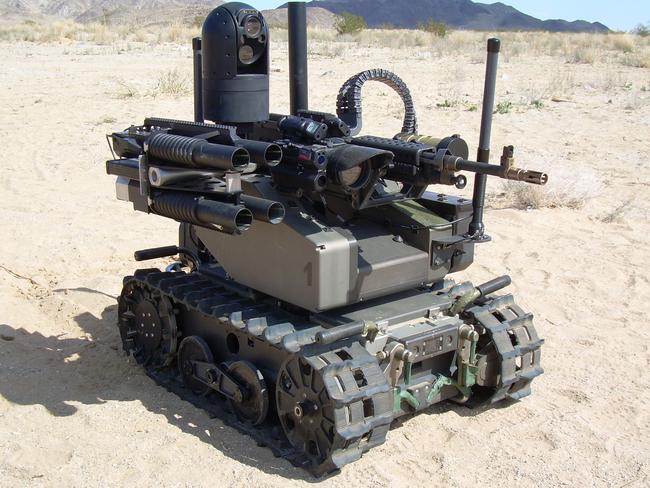United Nations to consider controls around autonomous weapons amid growing concerns
THE United Nations has moved towards a debate on restricting autonomous weapons as experts warn they could be turned against us.
A SPECIAL United Nations panel has agreed to move ahead with talks to define and possibly set limits on weapons that can kill without human involvement.
The discussions come as human rights groups claim governments are moving too slowly to keep up with advances in Artificial Intelligence that could put computers in control one day.
Advocacy groups warned about the threats posed by such “killer robots” and aired a chilling video illustrating their possible uses on the sidelines of the first formal UN meeting of government experts on Lethal Autonomous Weapons Systems late last week.
More than 80 countries were involved in the talks to discuss the potential of drafting a legally binding instrument, a code of conduct, or a technology review process for autonomous weapons.
The Campaign to Stop Killer Robots, an umbrella group of advocacy groups, said 22 countries supported a ban of the weapons and the list was growing.
Professor Toby Walsh from the University of New South Wales’ School of Computer Science and Engineering has been at the forefront of the push for an international agreement for restrictions on killer robots.
He recently co-ordinated the release of an open letter to the United Nations signed by 116 industry experts including Elon Musk and Mustafa Suleyman, the founder and head of applied artificial intelligence at Google’s DeepMind Technologies.
“Lethal autonomous weapons threaten to become the third revolution in warfare,” the letter said.
“Once developed, lethal autonomous weapons will permit armed conflict to be fought at a scale greater than ever, and at timescales faster than humans can comprehend. These can be weapons of terror, weapons that despots and terrorists use against innocent populations, and weapons hacked to behave in undesirable ways.
“We do not have long to act. Once this Pandora’s box is opened, it will be hard to close.”

Last week’s meeting fell under the UN’s Convention on Certain Conventional Weapons — also known as the Inhumane Weapons Convention — a 37-year old agreement that has set limits on the use of arms and explosives like mines, blinding laser weapons and booby traps over the years.
The group operates by consensus, so only the least ambitious goals are likely to prevail, and countries including Russia and Israel have firmly staked out opposition to any formal ban.
UN officials say in theory, fully autonomous, computer-controlled weapons don’t exist yet but defining exactly what killer robots are and how much human interaction is involved was a key focus of the meeting.
The United States argued that it was “premature” to establish a definition.
A NEW ARMS RACE
The concept stirs the imagination and fears of the public, in part because it has been widely dramatised in Hollywood science-fiction films that have depicted uncontrolled robots firing their weapons and killing people. But Ambassador of India, Amandeep Gill, who chaired the gathering, played down such concerns.
“Ladies and gentlemen, I have news for you: The robots are not taking over the world. So that is good news, humans are still in charge ... We have to be careful in not emotionalising or dramatising this issue,” he told reporters.
Others, however, see a worrying trend emerging in the defence industries.
Professor Walsh has previously travelled to speak in front of the United Nations in an effort to have the international body prevent the proliferation of killer robots. Speaking to news.com.au earlier in the year, Professor Walsh said world governments were already embarking on an autonomous weapons arms race.
“They get in the hands of the wrong people and they can be turned against us. They can be used by terrorist organisations,” he warned.
“It would be a terrifying future if we allow ourselves to go down this road.”
- With AP



